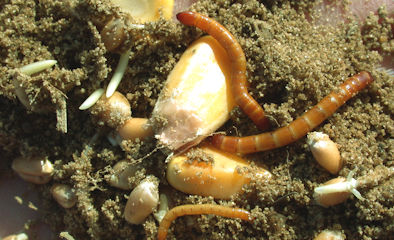
Once upon a different lifetime, wireworms infested a couple of our fields. Afterwards we put out bait stations there every year. Are wireworms still an issue? If so, are bait stations still an option?
Our Indiana Certified Crops Adviser panel includes Greg Kneubuhler, G & K Concepts, Harlan; Jesse Grogan, LG Seeds, Lafayette; and Tom Stein, Ceres Solutions, Benton County.
Here is their take on wireworm today.

Are wireworms still an issue? If so, are bait stations still an option?
Grogan: Seed treatment with neonicotinoid insecticides like Poncho and Cruiser are effective against wireworms, mostly by suppressing them. Higher rates of neonicotinoids are more helpful but don’t kill many (wireworms.) Sometimes wireworms are so dense suppression doesn’t work. Bait traps can be used to evaluate the potential for future damage. Wireworms aren’t evenly distributed, but occur instead in clumps or hot spots. These are usually associated with low spots, where grass weeds are more common or in fields rotating out of pasture. Wireworms live in the soil for two to six years, depending upon species. They live about two feet deep, and move to the top two to three inches of soil when soil temperatures reach 50 to 60 degrees F.
Stein: Wireworms can cause significant damage to both corn and soybeans by attacking seeds before, during and after germination. They also feed on emerged seedlings, causing stunting, wounds which can let diseases in and even cause plant death. Wireworm populations will tend to be higher in fields that are no-till, (continually) wet, weedy or have been in perennial sod or a cover corp. There are no rescue treatments. Due diligence must be performed prior to planting.
Kneubuhler: Wireworms tend to be soil-specific, and are often found in high organic matter soils, muck soils and fields where small grains were grown. Unless you’re aware of wireworm problems, seed treatment insecticides are typically adequate. If you suspect heavier pressures, a soil-applied insecticide will be required.
Grogan: Bait traps are made two weeks before planting corn in five to 10 places per 40-acre field. You can use corn seed, pre-soaked for a day with water. Bury one to two cups about four inches deep. Mound soil over the top and cover with black plastic first, then clear plastic. Cover edges with soil. Mark each location with a flag so you can find them again.
If one or more wireworms are recovered per trap, control with insecticide is justified. In-furrow applications of Regent or bands of Counter are effective for long-term control when infestations are heavy.
Stein: If you find one wireworm per bait stations (average) and intend to plant corn, the very least you should do is use a seed treatment with the high rate, or 1.25 mg of active ingredient per kernel, of clothiandin (Poncho 1250) or thiamethoxam (Cruiser Maxx 1250). If there is more than one wireworm per station, consider using granular or liquid soil insecticides plus seed treatment.
Bait and switch (see below): If you think wireworms could be problem in a field, follow Grogan’s instructions to put out a bait trap. Everything you need is on the left. When you come back two to three weeks later and dig up the trap, if you find this many wireworms, as on the right, you may want to switch up your insecticide program as Stein, Kneubuhler and Grogan suggest. (Photos courtesy John Obermeyer, Purdue University Extension entomologist)
About the Author(s)
You May Also Like




